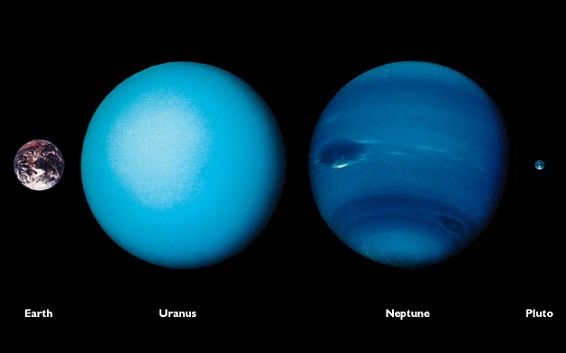Our Most Detailed Knowledge of Uranus and Neptune Comes From:
Compared with Uranus the planet Neptune is. Undoubtedly the Jovian aurora is the most studied and Neptunian aurora the least the geocentric distance effect.

Uranus Neptune Earth Pluto Size Comparison Retrograde Motion Planetary Retrograde
View Test 3 Key Astronomydocx from ASTR 1303 at Austin Community College District.

. 161 1 Our most detailed knowledge of Uranus and Neptune comes from spacecraft exploration 2 In terms of axial tilt which of the jovian planets shows us the largest inclination. C ground based visual telescopes. Our most detailed knowledge of Uranus and Neptune comes from A the Hubble Space telescope.
The Uranus Neptune mutual reception Uranus in Pisces Neptune in Aquarius makes it possible to conciliate these tendencies serving for a gradual awakening of the Soul of the World to the values of the Aquarius Age. B the Hubble Space telescope. Our most detailed knowledge of Uranus and Neptune comes from.
January 6 2021. The legacy of the Voyager mission still dominates our knowledge of the Uranus and Neptune ring-moon systems. Our most detailed knowledge of Uranus comes from.
The most detailed information about the gas giants has come from 1 the Voyager 1 and 2. In terms of axial tilt which of the Jovians shows the largest inclination. While they may not get as much attention as the more popular planets closer to the Sun each is unique in its own mysterious way.
Most of our detailed information about them comes from fleeting looks by the Voyager 2 spacecraft in the 1980s. Beyond the orbit of Saturn in the cold and dark depths of the outer Solar System lie the giant planets Uranus and Neptune along with a dwarf planet and the former ninth planet in the Solar System Pluto. Orbiter missions to Uranus and Neptune are being considered this thread gives lots of detail on tradeoffs probe size calculations etc but they have to compete with other scientific missions.
The only spacecraft to have visited Uranus and Neptune was. Because of their great distance from Earth and the interference of the Earths atmosphere telescopes are of limited use in gathering scientific information about these planets. The implied input power in the auroral zones is estimated to be about 101W on Jupiter about 1000 times more than in Earths auroral regions 10-1012 W on Saturn -10-102 W on Uranus and around 109 W on Neptune.
B the Hubble Space telescope. Voyagers cameras also first revealed eleven small inner moons at Uranus and six at Nep- tune. 1781 Neptune- 海王星 the star of the king of the sea.
Uranus 3 At which planet can the pole remain in darkness for 42 years then have 42. That legacy includes the first clear images of the nine narrow dense Uranian rings and of the ring- arcs of Neptune. C ground based radio telescopes.
Answer 1 of 7. Dwarf planets such as Pluto. Mark your answers on both the scantron and.
Neptune is within two degrees of Capricorn and your Ascendant line within 1 deg making them both cusps thereby retaining the a. I have searched for other Uranus-Neptune mutual receptions in the 2000 BC - 3000 AD period 5000 years and the results of this study shows that because. Our most detailed knowledge of Uranus and Neptune comes from.
D ground-based visual telescopes. The spacecraft Cassini went into orbit around. E ground based visual telescopes.
Test 3 Solar System Astronomy Spring 2019 Name _ Part 1 Multiple Choice. Which three played a role in the. Uranus -天王星 the star of the king of the sky.
Our most detailed knowledge of Uranus and Neptune comes from. D ground based radio telescopes. Using images snapped by a NASA spacecraft 25 years ago a scientist has created the most detailed-ever map of Triton one of the few.
Our knowledge of the gas giant planets comes from two sources ground based telescopes and spacecraft. Aerobraking depends on detailed knowledge of the atmosphere and its variability and we just dont have enough of that for Uranus or Neptune. Our solar system consists of our star the Sun and everything bound to it by gravity the planets Mercury Venus Earth Mars Jupiter Saturn Uranus and Neptune.
The ice giant planets Uranus and Neptune represent an important and relatively unexplored class of planet. The only spacecraft to have visited Uranus and Neptune was. E ground-based radio telescopes.
And millions of asteroids comets and meteoroids. Named after the ancient Greek deity of the sky- Uranus. Named after the Roman god of the sea- Neptune aka.
Im not sure who does your calculations but by the charts I use it actually seems that your ascendant lies in Aquarius with Uranus Neptune and Ketu. The planetary system we call home is located in an outer spiral arm of the Milky Way galaxy. Roughly the same size.
5 years ago. Practice all cardsPractice all cardsPractice all cardsdone loading. Our most detailed knowledge of Uranus and Neptune comes from.
Our most detailed knowledge of Uranus and Neptune comes from. William Herschel thought he has found a comet when he spotted the green disk of.

Views Of Uranus Top And Neptune Bottom From Spacecraft Download Scientific Diagram

Mysterious Uranus And Why We Need To Put An Orbiter Around It Uranus Astronomy Space And Astronomy


Comments
Post a Comment